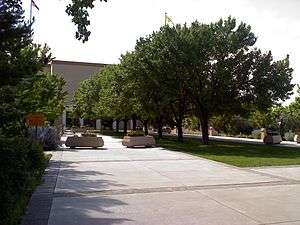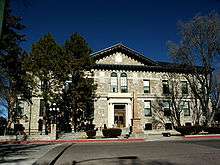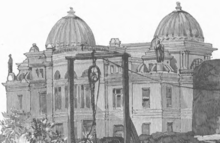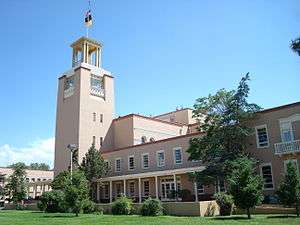New Mexico State Capitol
The New Mexico State Capitol, located in Santa Fe at 490 Old Santa Fe Trail, is the house of government of the U.S. state of New Mexico. It is the only round state capitol in the United States, and is known informally as "the Roundhouse".


Design

The building was designed to resemble the Zia sun symbol when viewed from above, with four entrance wings that protrude from the main cylindrical volume. Architecturally, the Capitol is a blend of New Mexico Territorial Revival style and neoclassical influences. Above each entrance is a stone carving of the State Seal of New Mexico. The building has four levels, one of which is below ground.
Dedicated on December 8, 1966,[1] the building was designed by W.C. Kruger and constructed by Robert E. McKee. Its extensive marble-work was installed by the New Mexico Marble and Tile Company. The capitol contains 232,346 square feet (22,000 m²) and was built for the cost of $4,676,860, or $20 per square foot ($215/m²).
The capitol houses the New Mexico State Legislature. The first floor (below ground) contains the semicircular House and Senate chambers, which are not accessible to the public. The second story, which is the ground floor, includes galleries where visitors can view the House and Senate chambers. The House gallery seats 281 people and is located on the south side of the building. The Senate gallery, which seats 206 people, is on the north side of the building. The two upper floors are mainly offices, with legislative committee offices on the third floor and the offices of the Governor, Lieutenant Governor, and Legislative Council Service on the fourth floor.

The Rotunda in the center of the building is 49 feet (15 m) in diameter and 60 feet (18 m) high, spanning the second, third, and fourth floors. The Rotunda is finished with Travertine marble native to New Mexico and inlaid with a turquoise and brass mosaic of the Great Seal of New Mexico. The ceiling skylight is designed to resemble an Indian basket weave, with blue and pale pink stained glass representing the sky and the earth, respectively. The flags of New Mexico’s 33 counties are on permanent display on the fourth floor balcony.
Surrounding the capitol is a lush 6.5-acre (2.6 ha) garden boasting more than 100 varieties of plants, including roses, plums, almonds, nectarines, Russian olive trees, and sequoias. Statues of native Pueblo peoples carrying pottery and hunting dot the property.
A renovation in 1992 included expansion of the committee rooms, asbestos abatement, mechanical and electrical improvements and greater accessibility for handicapped people. The building was rededicated on December 4, 1992.
Capitol Art Foundation
The Legislature created the Capitol Art Foundation in 1991, which has since become one of the building's most endearing features. The Foundation was created to assist in the acquisition of art for permanent, public exhibition in the State Capitol. The Collection features contemporary masterworks by artists who live and work in New Mexico. The Capitol Art collection is housed throughout the public areas of the building on all four floors. The Collection consists of a wide range of media, styles and traditions, including handcrafted furniture groupings. The mission of the Capitol Art Foundation is to collect, preserve, exhibit, interpret and promote appreciation of works of art that represent the history, cultures and art forms of the people of New Mexico.
Governor's Gallery
The Governor's Gallery is located on the fourth floor of the New Mexico State Capitol. It was conceptualized and created by Allan Pearson, cultural liaison to Governor Jerry Apodaca in 1975 as a space to educate the public about the artistic heritage of the state. The first exhibition featured paintings made by Georgia O'Keeffe.[2] It rotates exhibitions several times a year, with the annual Governor's Awards for Excellence in the Arts exhibition held every fall.[3]
Previous capitol buildings
The Roundhouse is the fourth Capitol building of New Mexico. The state boasts not only the third-newest capitol in the U.S. (only those in Hawaii and Florida, completed in 1969 and 1978, respectively, are newer) but also the oldest, the Palace of the Governors.
Palace of the Governors

Built in 1610 by the Spanish, the Palace of the Governors is located on the Santa Fe Plaza. It was the house of government in Santa Fe for nearly three centuries, during periods of Spanish and Mexican rule. When New Mexico was annexed by the United States in 1846, it became the first territorial capitol and was used as such for forty years. Now a museum, the Palace is the only capitol in the U.S. that has housed the governments of three different nations.
1850 Capitol (federal courthouse)

In anticipation of New Mexico's statehood, work began on a new capitol building in 1850. However, the funding for its construction was quickly exhausted, and in 1855 work on the project was halted with only the first story of the building completed. It remained in this state until 1886, when the second story and roof were finally finished. However, by this time a new territorial capitol was already being constructed, so the old building was never officially used as the capitol. (It did temporarily house the territorial government between 1892 and 1900.) Instead, it became the Territorial (later Federal) Courthouse. This building still stands in its original form.
1886 Capitol


In 1886, a new building replaced the antiquated Palace of the Governors as the territorial capitol. Four stories high, the monumental building was constructed from sandstone quarried in Lamy and topped by colossal bronze statues representing Liberty, Justice, Commerce and Industry. It was designed by Chicago architect E. S. Jennison. Six years after its opening, on the evening of May 12, 1892, a fire began and destroyed the structure, though bystanders were able to save most of the archives, books, and furniture. The building was uninsured and its loss cost the state over $200,000. [4]
An investigation concluded the fire was set deliberately, as it reportedly broke out in two separate areas simultaneously and a crucial emergency hose seemed to have been sabotaged. [5] The identity and motive of the perpetrator were never determined.
1900 Capitol (Bataan Memorial Building)

The next capitol building, designed by Isaac Rapp, was not completed until 1900.[6] In the meantime, the government was housed in the Territorial Court House, and the adjoining judicial offices. After the costly loss of the previous building, the new capitol was completed on a shoestring budget of less than $140,000, using salvaged materials and unpaid convict labor from the Penitentiary of New Mexico to save money. The building was three stories high with a silver dome, cupola, and neoclassical portico. The first story was constructed from sandstone reused from the old capitol, while the second and third floors were yellow brick and the portico was Indiana limestone.[7][8] It was dedicated on June 4, 1900.[9]
In this building, at 1:35 P.M., January 6, 1912, President William Taft signed the proclamation admitting New Mexico as the 47th state of the Union. He then turned to the delegation and said, "Well, it is all over. I am glad to give you life. I hope you will be healthy."

During the next several decades, various additions were built adjacent to the capitol building. In 1950 a major project was begun to unify the architectural appearance of all the buildings in the government complex to the Territorial Revival style. The dome, which had often been criticized as not appropriate for the state, was removed and a 105-foot (32 m) tower was added at the north end of the building. The building is now known as the Bataan Memorial Building, to commemorate the Bataan Death March. It houses numerous offices of the State Government. The old capitol is almost entirely obscured by the later additions, or in the case of the pedimented portico, removals, but its third-story arched windows are still recognizable.
References
- Price, Jay M. (Winter 2000). "CAPITOL IMPROVEMENTS: Style and Image in Arizona's and New Mexico's Public Architecture". The Journal of Arizona History. 41 (4): 371. JSTOR 41696605.
- Burke, Flannery (2008). From Greenwich Village to Taos : Primitivism and Place at Mabel Dodge Luhan's. Lawrence, Kansas: University of Kansas Press. p. 184. ISBN 9780700615797.
- "New Mexico State Capitol". TOURISM Santa Fe. Retrieved 11 January 2016.
- "Incendiary: Defective Water Service in the Building—The Domes Ablaze and the Hose Cut". Santa Fe New Mexican. May 14, 1892. Retrieved March 16, 2018 – via Library of Congress.
- "Reward for the Capitol Burners". Santa Fe New Mexican. May 24, 1892. Retrieved March 16, 2018 – via Library of Congress.
- Sheppard, Carl D. ‘’Creator of the Santa Fe Style: Isaac Hamilton Rapp, Architect’’, University of New Mexico Press, Albuquerque, New Mexico, 1988 pp. 42-45
- "The new capitol almost completed". Santa Fe New Mexican. June 13, 1899. Retrieved March 17, 2018 – via Library of Congress.
- "The new capitol". Santa Fe New Mexican. March 26, 1898. Retrieved March 17, 2018 – via Library of Congress.
- "Dedication of the New Capitol a Memorable and Interesting Event; A Civic and Military Pageant". Santa Fe New Mexican. June 5, 1900. Retrieved March 17, 2018 – via Library of Congress.
External links
- Bataan Memorial Building at
- Federal Courthouse at 35.690912°N 105.937653°W
